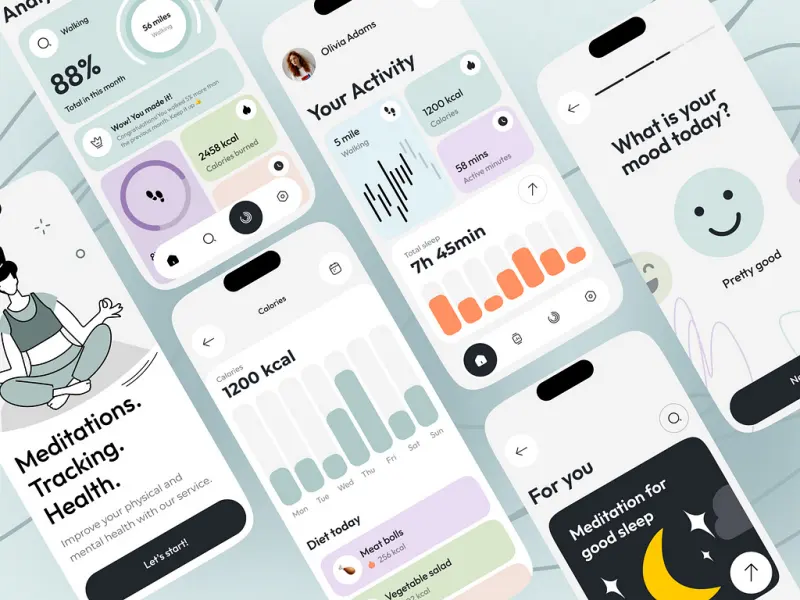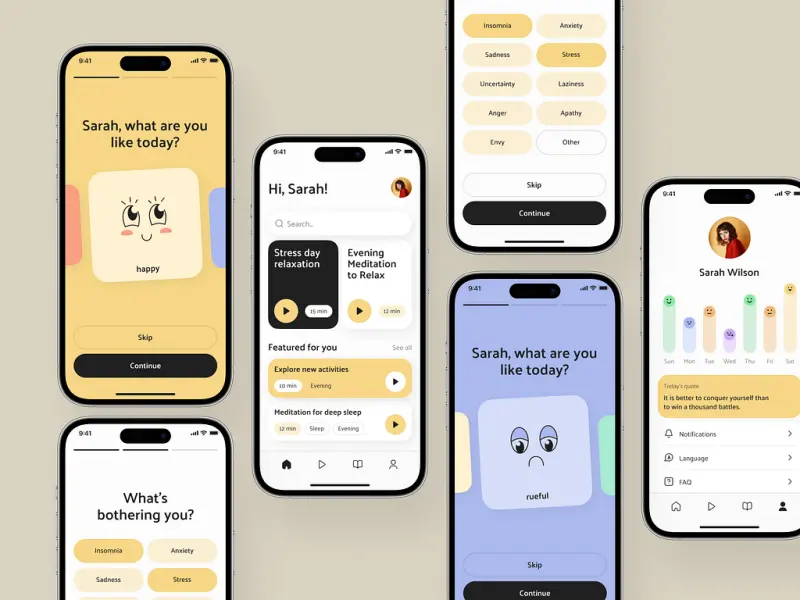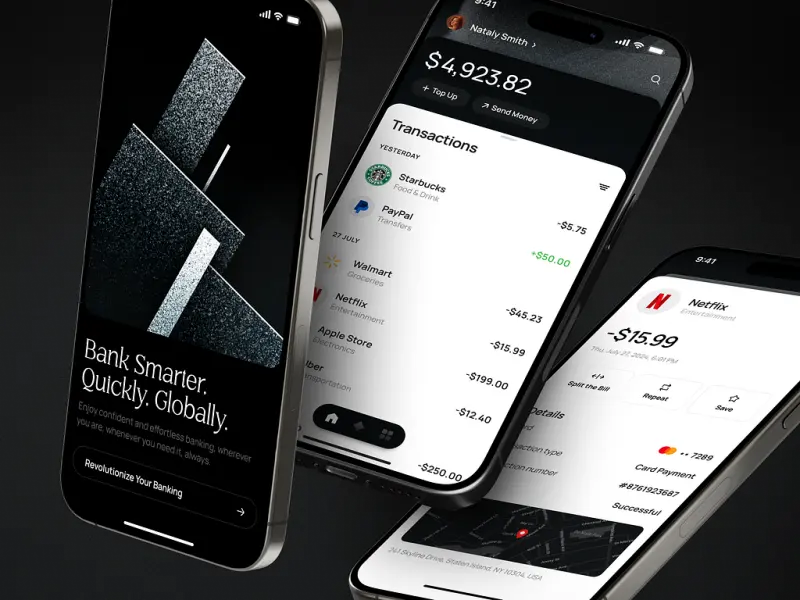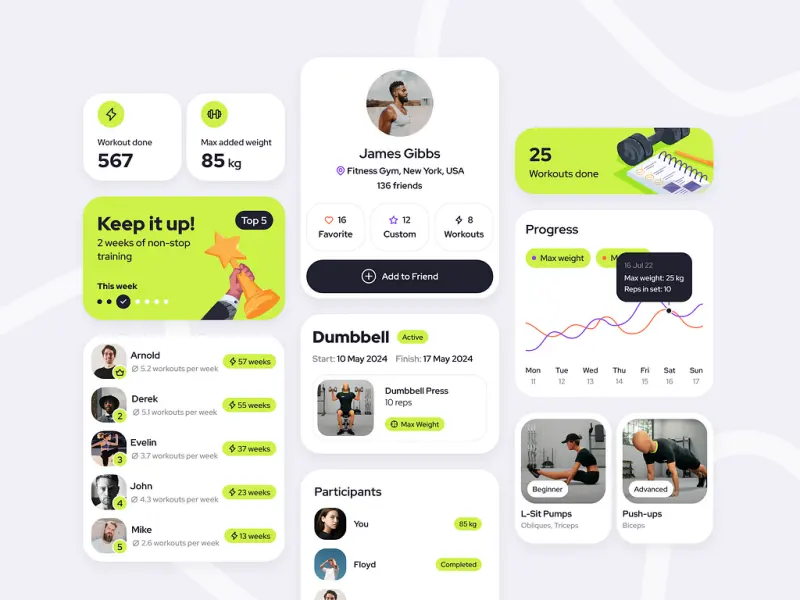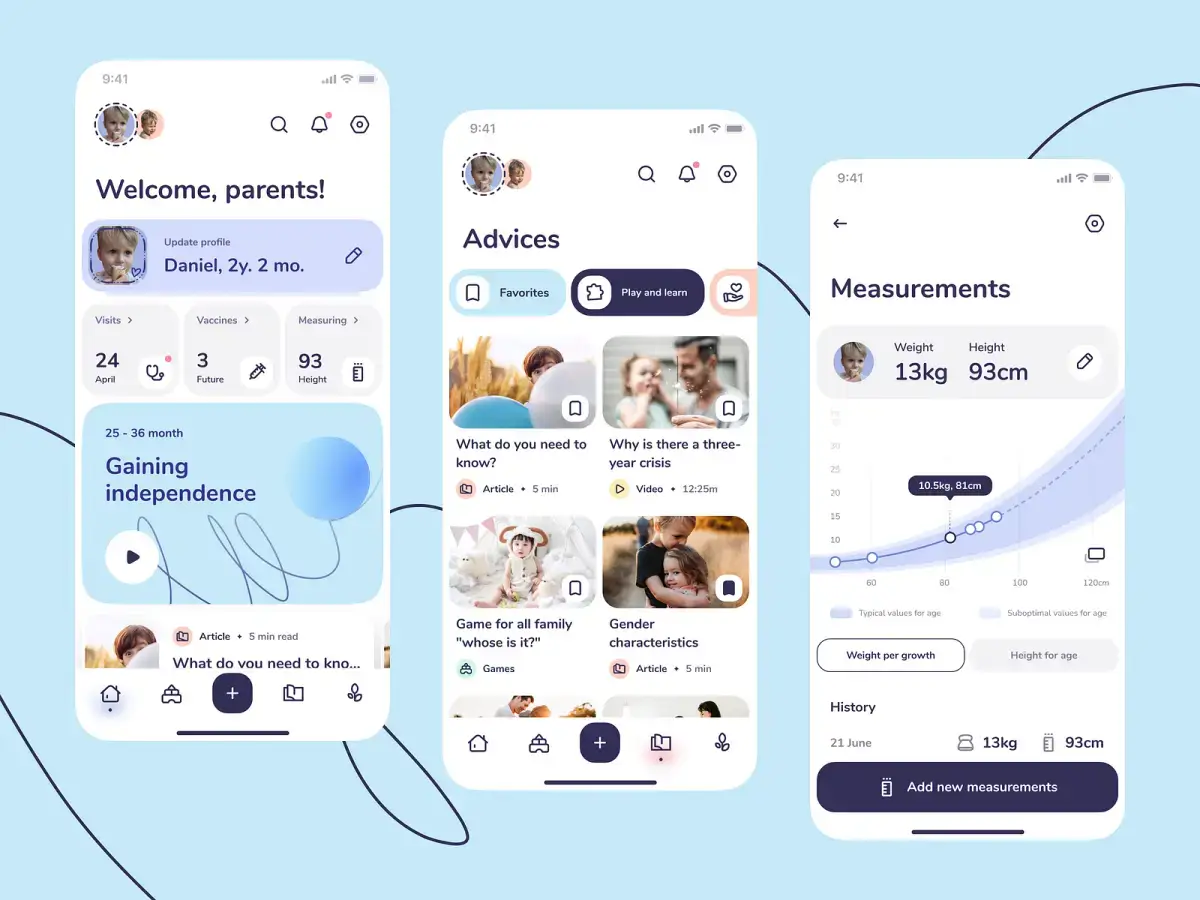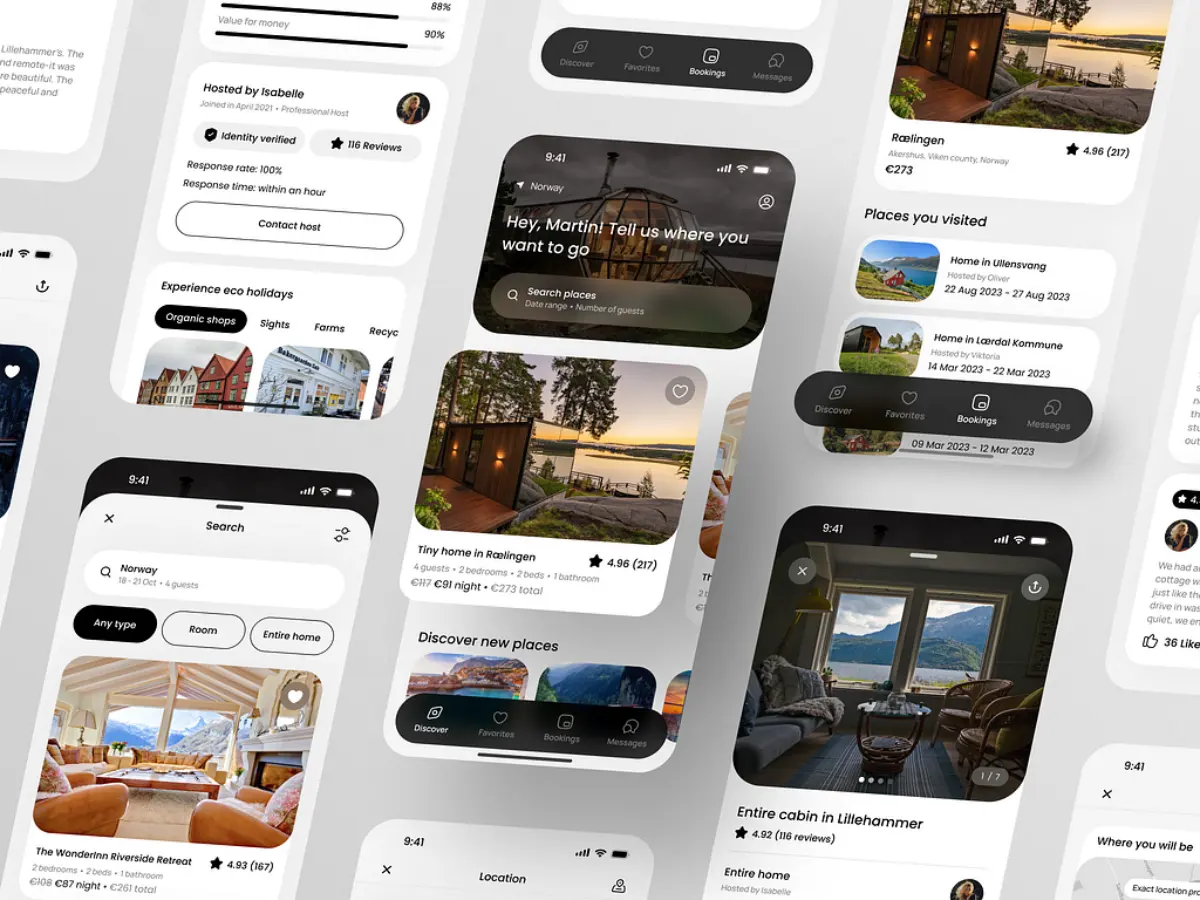App Design Cost: Key Factors and Price Ranges for 2025
- TECHVIFY Team
- 0 Comments
Mobile app design cost calculation is a crucial step in business processes. To answer the question, “How much does it cost to design an app?”, we need to explore fundamental aspects that provide a rough idea of app design price.
Mobile app development is a comprehensive and multi-level process requiring various resources. But first, let’s focus on mobile app design and its costs, as design is the first thing that grabs attention. This guide will cover the factors influencing app design costs and the factors influencing it.
I. The Importance of App Design in Today’s Market
In a competitive app market expected to reach $407.31 billion by 2026 (Allied Market Research), design is a make-or-break factor. Poorly designed apps face high uninstall rates—nearly 49% of Android apps are deleted after just one use. Similarly, 57% of users avoid recommending businesses with bad mobile design, and 90% abandon apps due to poor performance.
Mobile app design cost
The mobile app design cost may seem like a significant investment upfront, but it’s critical to:
- Attract and Retain Users: A visually appealing interface and intuitive navigation keep users engaged.
- Enhance Brand Image: A polished design strengthens your brand’s credibility and makes a lasting impression.
- Boost Conversion Rates: Research from Forrester shows that every dollar spent on UX can yield a $100 return, with conversion rates increasing by up to 400%.
- Gain a Competitive Edge: A well-designed app not only improves user experience but also positions your business ahead of competitors.
While minimizing the app design price might save money initially, it risks long-term losses in user retention, revenue, and brand reputation.
II. What Factors Influence Mobile App Design Costs?
When considering how much app design costs, it’s essential to understand the key factors that influence the mobile app design cost for proper planning. Whether you’re building a simple interface or a complex, multi-functional platform, several technical aspects can drive the price and timeline of app design. Let’s explore these factors in detail to help you make informed decisions.
Factor 1: Design Type
The type of design you choose plays a significant role in determining the cost of mobile app design. Broadly, there are two types of designs to consider—custom design and native design. Each comes with its own set of advantages, challenges, and price points.
Type 1: Custom Design
A custom design involves building a unique User Experience (UX) and User Interface (UI) tailored specifically to your app’s goals. Unlike pre-made libraries or templates, custom design starts from scratch, offering unparalleled flexibility and exclusivity.
Why Consider Custom Design?
Custom designs are ideal for apps that want to stand out, even if this results in a higher app design cost. Apps like Uber, Tinder, and Airbnb have invested heavily in custom designs to create groundbreaking success. If you fully understand your audience’s needs, pain points, and engagement expectations, a custom approach can set you apart.
Pros:
- Uniqueness: A custom design ensures your app stands out by offering a one-of-a-kind user experience. With this approach, you can control the design cost while still creating something exclusive. However, designers must adhere to core UX principles to maintain usability.
- Branding: Customization allows you to align the app design with your organization’s vision and values. It’s an opportunity to create a strong, visual representation of your brand.
- Creative Potential: With no predefined limits, you have the freedom to explore innovative ideas and advanced design elements.
Cons:
- Higher Costs: Custom designs can be more expensive due to the time, effort, and expertise required. Costs can vary depending on the complexity of the design and the level of skill your designers bring to the table.
- Resource Intensive: Hiring experienced designers who understand the nuances of custom design while balancing costs can be challenging.
App design price
Type 2: Native Design
Native design, on the other hand, can be a more affordable option for businesses looking to control the mobile app design cost while maintaining platform-specific functionality. It focuses on leveraging the pre-existing design frameworks and functionalities of the platform.
When to Choose Native Design?
Native design is ideal for apps where functionality and speed are priorities. Apps like WhatsApp and Twitter use native design to maintain simplicity and platform consistency. If you’re looking to save time and costs without compromising usability, native design is a great option.
Pros:
- Lower Costs: Native design tends to be more cost-effective since it relies on platform standards, reducing the need for custom development.
- Easy Implementation: Designers work within familiar systems, making the design process simpler and quicker.
- Faster Development: High-quality templates and platform-specific guidelines enable faster turnaround times compared to custom designs.
Cons:
- Limited Creativity: Native design frameworks can restrict creativity, leaving less room for experimentation or unique visual elements.
- Feature Limitations: Designers are often confined to platform-specific design elements like buttons, scrollers, and layouts, which may limit customization options.
Factor 2: App Complexity
The complexity of your app is another major factor that impacts design costs. Complexity is typically determined by aspects like the number of screens, roles, and features required.
Number of Roles
The more unique features you want in your app, the more specialized roles you’ll need on your design team. For an average project, you’ll likely require:
- A project manager to oversee the process.
- UI/UX designers to create wireframes, prototypes, and user-friendly interfaces.
- A research specialist to develop user personas and gather feedback.
- A tester to ensure that the app meets user expectations and functions smoothly.
As the complexity increases, additional expertise (e.g., animation specialists or interaction designers) may also be necessary, which can drive up costs.
Number of Screens
The number and type of screens in your app also play a critical role in determining costs. Here are some common examples:
- Welcome screens to create a great first impression.
- Onboarding screens that guide users through the app’s features.
- Login screens with secure authentication options.
- Screens for errors, buttons, and menus that ensure smooth navigation.
If you plan to include animations or dynamic elements on these screens, the cost will naturally increase. Apps with numerous interactive screens significantly increase the mobile app design cost, requiring more time and effort to complete.
Number of Features
The complexity of your app’s features directly influences both the design cost and duration. Key aspects to consider include:
- Platform Choice: Whether you’re building for iOS, Android, or a cross-platform solution can affect costs. iOS apps, for instance, often require adherence to stricter guidelines, which can increase the price.
- Type of App: Are you designing a lightweight MVP (Minimum Viable Product) or a fully functional app with advanced capabilities? MVPs are typically more cost-effective.
- Advanced Technologies: Incorporating cutting-edge features like AR, VR, AI, or ML can significantly increase design costs.
- User-Specific Elements: Apps tailored to a specific user cohort may require additional customization, which adds to the cost.
By estimating the number of hours required for each feature, you can get a clearer idea of the overall cost.
App Design Cost
Factor 3: Design Team Model
The team you choose to design your app is one of the most significant factors influencing the cost. Whether you hire an in-house team, a local agency, or freelancers, or opt for outsourcing, each option has its own price range, pros, and cons. Let’s break them down to help you make the best decision for your project.
1: In-House Team
An in-house team consists of employees who work directly for your company. While this setup offers greater control over the project, it can also be resource-intensive.
Pros:
- Full Control: With an in-house team, you have direct oversight of all activities, ensuring that the design aligns perfectly with your vision.
- Deeper Involvement: Employees are immersed in your company’s values, culture, and brand philosophy, which helps them better understand the product and its goals.
- High Performance: In-house developers focus solely on your project, ensuring their time and effort are fully dedicated to its success.
Cons:
- High Costs: Hiring an in-house team is often the most expensive option, requiring significant investment in salaries, benefits, and infrastructure.
- Risk of Burnout: Since in-house employees are focused on just one project, they may experience creative fatigue or burnout over time.
- Resource-Heavy: If team members fall sick or leave, you’ll need to allocate additional time and money to hire and train replacements, further straining your resources.
When to Consider In-House Teams?
In-house teams are ideal for long-term projects or companies that require constant updates and maintenance. However, for smaller businesses or startups, the high costs may outweigh the benefits.
2: Local Design Agency
A local design agency offers professional services within your geographical location. This option provides a balance of expertise and convenience, but it comes at a higher cost.
Pros:
- Market Familiarity: Local agencies understand your market and can incorporate regional insights into the app design.
- Better Communication: Face-to-face meetings and instant updates improve collaboration and minimize misunderstandings.
- Active Participation: You can work closely with the team, monitoring their progress and contributing to the creative process.
- Local Resources: Agencies can leverage local branding ideas and networks to enhance your app’s appeal.
Cons:
- Higher Costs: Depending on your location, local agencies may charge premium rates. For example, in the USA, rates can average $150 per hour.
- Limited Flexibility: You are restricted to the personnel and expertise within the agency, leaving little room to change the team if issues arise.
- Variable Quality: While some agencies deliver exceptional work, others may underperform, making research and vetting critical.
When to Consider Local Agencies?
This option works well if you prioritize close communication, market-specific insights, and a hands-on approach, provided your budget can accommodate the higher rates.
3: Freelancers
Freelancers are individual specialists you can hire for specific tasks within your app design project. While they are budget-friendly, managing multiple freelancers can be challenging.
Pros:
- Cost-Effective: Freelancers typically charge lower rates, with design costs ranging between $15 to $25 per hour.
- Quick Availability: Freelancers are often easier to hire and can start working on your project almost immediately.
- Specialized Expertise: You can hire freelancers with specific skill sets tailored to your project needs.
Cons:
- Reliability Issues: Freelancers may not always meet deadlines or deliver consistent quality, which can disrupt your timeline.
- Management Challenges: Coordinating multiple freelancers for different roles (e.g., UI design, prototyping, testing) can be time-consuming and prone to miscommunication.
- Rework Risks: Without proper oversight, you may face repeated revisions, which could offset the initial cost savings.
When to Consider Freelancers?
Freelancers are a great option for small projects or startups with limited budgets. However, careful vetting and strong project management are essential to mitigate risks.
4: Outsourcing Agency
Outsourcing agencies, especially in regions with lower labor costs, can help reduce your app design cost while still delivering professional results.
Pros:
- Access to Top Talent: Outsourcing agencies give you access to skilled professionals worldwide, ensuring high-quality design.
- Cost Savings: Rates can be significantly lower; for instance, agencies in Vietnam charge as little as $20 per hour.
- Resource Efficiency: By outsourcing, you save time and effort on recruitment, training, and infrastructure.
- Fresh Perspectives: Working with international teams can bring fresh ideas and innovative solutions to your project.
Cons:
- Time Zone Differences: Communication can be challenging due to time gaps, potentially delaying updates and feedback.
- Limited Control: You may have less oversight over the design process, which could lead to unexpected outcomes.
- Transparency Issues: Some agencies may not provide clear updates or reports, requiring extra effort to ensure accountability.
When to Consider Outsourcing Agencies?
Outsourcing is ideal for businesses looking to reduce costs without compromising quality. It’s especially beneficial for startups or companies operating on tight budgets.
Looking to Outsource Development?
Contact TECHVIFY – Vietnam’s Leading Offshore Software Development & Outsourcing Company, for consultation and development services.
III. What’s the Cost to Design a Mobile App?
The cost of designing a mobile app can range from $3,000 to $30,000, depending on the factors we have mentioned. To better understand how these factors impact your budget, let’s break down the costs based on complexity, team type, and location.
How much does it cost to design an app
Cost Based on Complexity
The complexity of an app influences the design costs significantly. It depends on factors such as the number of screens, unique features, usability, and visual design. These elements also reflect the business model’s complexity, which directly impacts the overall budget.
Here’s a breakdown of app design costs by complexity:
| Complexity | Average Cost ($) |
|---|---|
| Simple App Design | 3,000 |
| Average App Design | 12,000 |
| Complex App Design | 30,000 |
In general, simpler app designs result in a lower app design price because they require less time and effort. On the other hand, complex designs with advanced features like AI/ML integration may have lower design costs but significantly higher development costs.
Cost Based on Team Model
The type of team you choose for your app design directly impacts the budget. For instance, an in-house team might provide more control, but it is the most expensive option. Here’s a cost estimate for designing an average-sized app requiring 300 design hours:
| Team Model | Average Cost ($) |
|---|---|
| In-house Team | 36,000 |
| Local Design Agency | 48,000 |
| Outsourcing Agency | 12,000 |
| Freelancers | 6,000 |
Each team type has its pros and cons, so the choice depends on your project’s needs, budget, and timeline. Outsourcing agencies, for example, are often a cost-effective solution without compromising quality, while freelancers work best for smaller, less complex projects.
Cost Based on Team Location
The cost of app design also varies widely based on the location of your design team. Experienced developers in the US, UK, or Western Europe typically charge higher rates than their counterparts in regions like Eastern Europe or South East Asia.
Using the same average-sized app requiring 300 design hours, here’s a cost comparison by region:
| Location | Average Cost ($) |
|---|---|
| Australia | 36,000 |
| The US | 48,000 |
| The UK | 40,000 |
| Western Europe | 28,000 |
| Eastern Europe | 12,000 |
| South East Asia | 9,000 |
By hiring a team in regions like South East Asia, you can significantly reduce costs while still accessing skilled professionals. However, it’s essential to ensure the quality and reliability of the team by thoroughly vetting their portfolio and expertise.
IV. How to Reduce App Design Costs
While app design is a crucial investment, there are strategies you can implement to minimize costs without sacrificing quality. Here are some practical tips:
- Plan Your Design Carefully
When it comes to mobile app design, careful planning is essential. To reduce the app design cost, spend time mapping out the app’s features and functionality, focusing on the most crucial elements. By having a clear plan from the start, you can avoid costly revisions and redesigns later. - Focus on Core Features
It’s tempting to include numerous features in your app, but focusing on the core functionality can save you money. Start with a prototype to test the basics and ensure your design aligns with user needs. Once the app is successful, you can gradually add advanced features. - Hire the Right Design Team
Working with a professional UI/UX design company can help you access cost-effective solutions tailored to your needs. These companies specialize in creating designs that are both functional and visually appealing, ensuring your app stands out in the market. - Design for Multiple Devices
To future-proof your app, it’s important to design for multiple devices, including smartphones, tablets, and desktops. This approach ensures your app works seamlessly across platforms and eliminates the need for costly redesigns later. - Plan for Future Updates
Think ahead when designing your app. By anticipating the release of new devices and operating systems, you can minimize the need for major updates. A forward-thinking approach will save time, money, and resources in the long run.
Conclusion
Designing a mobile app is not just about creating visually appealing interfaces; it’s about crafting a seamless user experience that drives engagement, builds credibility, and delivers measurable results. While the costs of mobile app design can vary widely, investing in a high-quality design ensures that your app stands out in today’s competitive market, retains users, and boosts your bottom line.
Partner with TECHVIFY for expert guidance and proven results. Let us help you achieve your goals while keeping your app design cost under control. Our team of skilled professionals specializes in cost-effective, high-quality app design and development services tailored to your business needs. Contact us today for a free consultation and take the first step toward building an app that delivers exceptional results.
TECHVIFY – Global AI & Software Solutions Company
For MVPs and Market Leaders: TECHVIFY prioritizes results, not just deliverables. Reduce time to market & see ROI early with high-performing Teams & Software Solutions.
- Email: [email protected]
- Phone: (+84)24.77762.666




